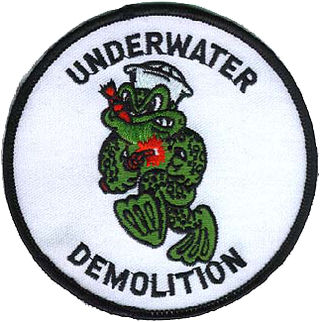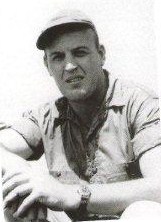
The United States Navy Sea, Air, and Land (SEAL) Teams, commonly known as Navy SEALs, are the U.S. Navy's primary special operations force and a component of the Naval Special Warfare Command. Among the SEALs' main functions are conducting small-unit special operation missions in maritime, jungle, urban, arctic, mountainous, and desert environments. SEALs are typically ordered to capture or kill high level targets, or to gather intelligence behind enemy lines. SEAL team personnel are hand selected, highly trained, and possess a high degree of proficiency in direct action (DA), and special reconnaissance (SR), among other tasks like sabotage, demolition, intelligence gathering, and hydro-graphic reconnaissance, training, and advising friendly militaries or other forces.

An inflatable boat is a lightweight boat constructed with its sides and bow made of flexible tubes containing pressurised gas. For smaller boats, the floor and hull is often flexible, while for boats longer than 3 metres (9.8 ft), the floor typically consists of three to five rigid plywood or aluminium sheets fixed between the tubes, but not joined rigidly together. Often the transom is rigid, providing a location and structure for mounting an outboard motor.

Landing craft are small and medium seagoing watercraft, such as boats and barges, used to convey a landing force from the sea to the shore during an amphibious assault. The term excludes landing ships, which are larger. Production of landing craft peaked during World War II, with a significant number of different designs produced in large quantities by the United Kingdom and United States.

Underwater Demolition Teams (UDTs), or frogmen, were amphibious units created by the United States Navy during World War II with specialized non-tactical missions. They were predecessors of the navy's current SEAL teams.

Amphibious warfare is a type of offensive military operation that today uses naval ships to project ground and air power onto a hostile or potentially hostile shore at a designated landing beach. Through history the operations were conducted using ship's boats as the primary method of delivering troops to shore. Since the Gallipoli Campaign, specialised watercraft were increasingly designed for landing troops, material and vehicles, including by landing craft and for insertion of commandos, by fast patrol boats, zodiacs and from mini-submersibles. The term amphibious first emerged in the United Kingdom and the United States during the 1930s with introduction of vehicles such as Vickers-Carden-Loyd Light Amphibious Tank or the Landing Vehicle Tracked.

The United States Naval Special Warfare Command (USNSWC), also known as, is the naval component of United States Special Operations Command, the unified command responsible for overseeing and conducting the nation's special operations and missions.

A Landing Craft Utility (LCU) is a type of boat used by amphibious forces to transport equipment and troops to the shore. They are capable of transporting tracked or wheeled vehicles and troops from amphibious assault ships to beachheads or piers.

Michael Edwin Thornton is a retired United States Navy SEAL and recipient of the U.S. military's highest decoration, the Medal of Honor, for his actions in the Vietnam War. He was awarded the medal for saving the life of his senior officer, Lieutenant Thomas R. Norris, who also earned the Medal of Honor in an unrelated incident.
Dennis Chalker is a retired Navy SEAL, inventor and author who has written six books about the United States Navy SEALs.

HMAS Assault is a former Royal Australian Navy (RAN) training centre that was in use during World War II, located at Nelson Bay in the Mid North Coast region of New South Wales, Australia.
Kevin Dockery is an American fiction and nonfiction author and military historian. He is best known for his work detailing the history and weapons of the Navy SEALs. He served in the US Army on the President's Guard, and as an armorer. Since retiring from the Army, he has worked as a curator for the SEAL Museum in Fort Pierce, Florida, an historian, a game designer and as a lecturer. He has written 37 books, appeared in a number of television documentaries and served as technical advisor for several motion pictures.

Phil Hinkle Bucklew was a professional American football player who went on to become a United States Navy officer. He served in one of the Navy's first special warfare units during World War II. While serving in the European Theater, he was twice awarded the Navy Cross, the second highest decoration in the United States Military.

An amphibious warfare ship is an amphibious vehicle warship employed to land and support ground forces, such as marines, on enemy territory during an amphibious assault.
The Fleet Landing Exercises, or FLEX were amphibious landing exercises conducted by the United States Navy and United States Marine Corps between 1935 and 1941. The purpose of these exercises was to formulate a workable amphibious warfare doctrine. The development of the necessary craft and other equipment, and the proper tactical deployment of them were also results. Finally, the exercises demonstrated the usefulness of a standing body of Marines, the Fleet Marine Force, specially prepared for amphibious expeditions.
The Observer Group was a joint-United States Army/Marine Corps unit that was the first in the United States and Fleet Marine Force to be organized and trained specifically for amphibious reconnaissance. The Observer Group experimented in the methodology and equipment for projecting reconnaissance from the sea before the establishment of the OSS Maritime Unit, the Underwater Demolition Teams, and before the Army Special Forces and Air Commandos. It was also the birth of naval amphibious intelligence.

The LCRL or LCR (L) (Landing Craft Rubber Large) was an inflatable boat which could carry ten men that was used by the United States Marine Corps and US Army from 1938 to 1945. 10,125 LCRLs were made during World War II. LCRL It had a weight of 320 pounds and were 18 feet by 8 feet. LCRL had a mount for an outboard motor, if stealth was not needed. The LCRL had a mount for a .30 cal. machine gun. With no armor, LCRL were often used at night for Amphibious warfare. Most were built by the Goodyear Tire and Rubber Company. *













